
| HOME | ENVIRONMENT | HEALTH STUDIES | CRUELTY-FREE | RECIPES | KIDS ZONE! | RESOURCES & LINKS |
FOOD'S ENVIRONMENTAL IMPACT:
CLIMATE CHANGE
Everyone should have one meat-free day a week to tackle climate change, says UN
Everyone should have one meat-free day a week to help save the planet, a leading expert on global warming has claimed. Dr Rajendra Pachauri, who chairs the United Nations Intergovernmental Panel on Climate Change, said meat farming produces enormous amounts of greenhouse gases. The environmental scientist, joint winner of the 2007 Nobel Peace Prize, said sticking to vegetables once a week would have more beneficial effects than reducing car journeys. 'Give up meat for one day (a week) initially,' the Indian economist recommended. 'In terms of immediacy of action and the feasibility of bringing about reductions in a short period of time, it clearly is the most attractive opportunity.'
Read more from The Guardian newspaper, UK.
Numerous international studies, such as those by the UN FAO and the Worldwatch Institute, reveal the significant impact of livestock agriculture on a wide range of environmental problems. In 2008 the Worldwatch Institute announced that livestock contribute more to global warming through greenhouse gas emissions than from all forms of transportation worldwide combined (at least 18%, with a 2009 paper reporting it as much higher).
Livestock are responsible for 18 percent of greenhouse gas (GHG) emissions, as measured in carbon dioxide equivalent, which is higher than the share of GHG emissions from transportation. They produce 37 percent of methane, which has more than 20 times the global warming potential of carbon dioxide, and they emit 65 percent of nitrous oxide, another powerful GHG, most of which comes from manure.
“Meat Production Continues to Rise,” Brian Halweil, WorldWatch.org August 20, 2008.
Video: Ed Hopkins, director of the Sierra Club's Environmental Quality program, discusses the environmental impacts of factory farming. See and learn more at www.platetoplanet.org.
Food miles are less important to environment than food choices, study concludes
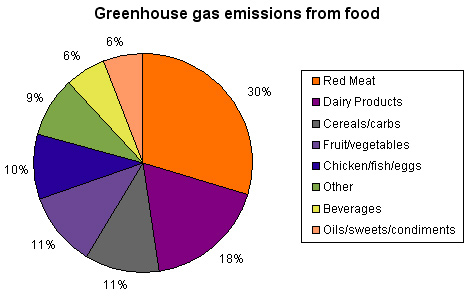 (Excerpt) Engineers Christopher Weber and H. Scott Matthews of Carnegie Mellon University in Pittsburgh
have found that although most foods in the U.S. are transported over long distances, the process of making the
food dominates greenhouse gas emissions. Indeed, they traced 83 percent of the average household's food-related
footprint of greenhouse gases to the origins of the food itself. Transportation only contributes 11 percent of
greenhouse gas emissions on average — with the transportation leg from producer to retailer accounting for just 4
percent.
(Excerpt) Engineers Christopher Weber and H. Scott Matthews of Carnegie Mellon University in Pittsburgh
have found that although most foods in the U.S. are transported over long distances, the process of making the
food dominates greenhouse gas emissions. Indeed, they traced 83 percent of the average household's food-related
footprint of greenhouse gases to the origins of the food itself. Transportation only contributes 11 percent of
greenhouse gas emissions on average — with the transportation leg from producer to retailer accounting for just 4
percent.
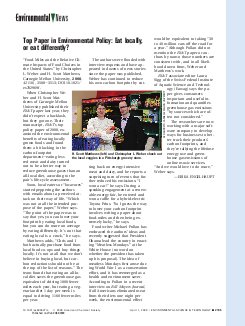 The start-to-finish process of raising and distributing red meat causes more greenhouse gas emission than any
other food group, with dairy products coming in second. Animal products create the greatest amounts of nitrous
oxide, emitted as a result of soil fertilization and management, because animals are inefficient at using plant
energy. Producing red meat and dairy also causes the bulk of all methane emissions, which are put out by ruminant
animals and manure fertilizer. Lower on the greenhouse gas emission scale are non-red meat protein sources such
as chicken, fish, eggs and nuts, as well as fruit and vegetables....
The start-to-finish process of raising and distributing red meat causes more greenhouse gas emission than any
other food group, with dairy products coming in second. Animal products create the greatest amounts of nitrous
oxide, emitted as a result of soil fertilization and management, because animals are inefficient at using plant
energy. Producing red meat and dairy also causes the bulk of all methane emissions, which are put out by ruminant
animals and manure fertilizer. Lower on the greenhouse gas emission scale are non-red meat protein sources such
as chicken, fish, eggs and nuts, as well as fruit and vegetables....
(Weber) stressed that their food miles study should not dissuade consumers from buying local foods. "Both myself and my coauthor believe there are many good reasons to buy locally, such as supporting local agriculture," Weber said. "A lot of people say local food is fresher and better-tasting. But given the choice, for the average consumer, buying local is not as important as what you eat.”
Read more at: Source.
And also at New Scientist: Environment : Food miles don't feed climate change — meat does.
And original study: “Food-Miles and the Relative Climate Impacts of Food Choices in the United States”: PDF.
A UN report concludes that animal agriculture is responsible for 18% of total greenhouse gas emissions, more than all transportation in the world combined. The most under-reported cause of global warming is the livestock industry, which accounts for a minimum of 18 percent of global warming, and, according to more updated information, is possibly responsible for 50 percent or more of the current emissions in the atmosphere. Lowering emissions by eliminating animal products from your life is one of the fastest, cheapest and most effective methods one can take to not only lower global emissions, but to bring abut rapid planetary cooling.
Source: Green Planet Awards: Livestock Industry & Global Warming
A study done at the University of Chicago in 2006 showed that an average household would reduce the impact of their greenhouse gas emissions by more if they halved their meat consumption than if they halved their car usage. “The difference between a meat-based and plant-based diet amounts to the same as driving an SUV versus a small sedan,” says Eshel, an Assistant Professor in Geophysical Sciences.
“We say that however close you can be to a vegan diet and further from the mean American diet, the better you are for the planet. It doesn't have to be all the way to the extreme end of vegan. If you simply cut down from two burgers a week to one, you've already made a substantial difference.”
Many people think that if they eat local, grass-fed beef, that it's better for the environment. But unfortunately it just isn't true. A study in the Journal of Animal Science comparing the methane emissions from grazing and feedlot cattle concluded that grass-fed cattle produce about 4 times more methane than grain-fed cattle.
“These measurements clearly document higher CH4 production (about four times) for cattle receiving low-quality, high-fiber diets than for cattle fed high-grain diets.”
For more information view the article MacLeans Magazine: Save the Planet: Eat Less Meat (Mar. 30, 2010)
Al Gore: I'm not a vegetarian but I have cut back sharply on the meat that I eat:
Excerpt from the film "Meat The Truth": The power to stop climate change is ours. What we choose to eat influences climate change more than anything else (2 minutes)
WORLD WATCH INSTITUTE: As environmental science has advanced, it has become apparent that the human appetite for animal flesh is a driving force behind virtually every major category of environmental damage now threatening the human future—deforestation, erosion, fresh water scarcity, air and water pollution, climate change, biodiversity loss, social injustice, the destabilization of communities, and the spread of disease.
Read more in the PDF World Watch Institute
Livestock accounts for 37 percent of human-induced methane, a gas with a global warming potential (GWP) 23 times that of CO2, largely through cattle flatulence and belching. It also generates 65 percent of humankind's nitrous oxide, which has a GWP 296 times that of CO2, mostly from manure, the FAO said in its 2006 report Livestock's Long Shadow. Then the eco-footprint of producing all the animals' feed must be factored in, as well as the carbon burned to power factory farms, slaughter houses and processing plants and refrigerate the meat. If all that were not enough, livestock is also a cause of widespread soil and water degradation, with major polluting agents including animal waste, antibiotics and hormones, chemicals from tanneries, and the fertilisers and pesticides used on feed crops.
These are the factors that led Yvo de Boer, executive secretary of the U.N. Framework Convention on Climate Change (UNFCCC), to say once that "the best solution would be for us all to become vegetarians." Dr Rajendra Pachauri, chair of the U.N. Intergovernmental Panel on Climate Change, and London School of Economics Professor Lord Stern are among the eminent names to express similar sentiments.
IPS Dec 17, 2009: 'Meat-Eating Gets Grilled'
Read the UN FAO's 'Livestock Impacts on the Environment' (2006)
SO HOW CAN WE MAKE A DIFFERENCE?
Meatless Mondays!
Since the UN's request to eat less meat in 2006, the global response has been inspiring. According to the Meatless Mondays campaign, worldwide ten million families, 7,000 hotels and 425,000 food dealers have pledged meat-free meals once a week. Baltimore City Public Schools launched Meatless Mondays for its 82,000 students in October. (Read an interesting article about that here). Thirty-two U.S. hospitals have signed on to the Balanced Menu Challenge, a commitment to reduce meat purchases by 20 percent. For more information, visit the campaigns around the world:
- Meatless Monday (Canada)
- Meatless Monday (US)
- Meat Free Monday (UK)
- Support Meat-Free Monday (Paul McCartney, UK)
A small town in Belgium has gone meat-free one day a week. A sign of things to come, says one food historian.
For decades, environmental arguments against eating meat have been largely the preserve of vegetarian websites and magazines. Just two years ago it seemed inconceivable that significant numbers of western Europeans would be ready to down their steak knives and graze on vegetation for the sake of the planet. The rapidity with which this situation has changed is astonishing.
...Read more at Global Action Network Can vegetarians save the world (May 28th 2009)
Take A Bite Out of Climate Change (A Project of the Small Planet Institute): 10 Ways to Take a Bite Out of Climate Change
TIME Magazine: Getting Real About the High Price of Cheap Food (By Bryan Walsh Friday, Aug. 21, 2009)
PDFs: Click on any image to download PDF (or the link below it to source) | ||
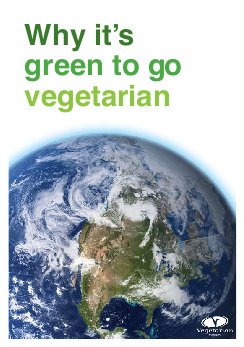 Why It's Green to Go Vegetarian |

Food-Miles and the Relative Climate Impacts of Food Choices in the US |
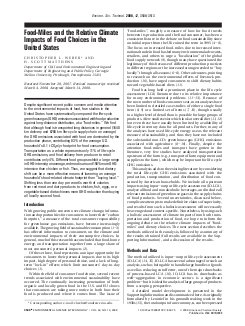
Food-Miles and the Relative Climate Impacts of Food Choices in the US |
 Livestock's Long Shadow |
 Earthsave Global Warming Strategy |
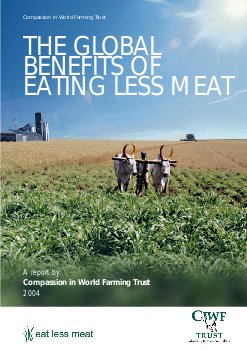 The Global Benefits of Eating Less Meat |
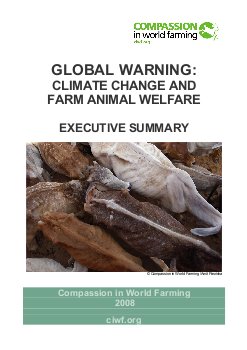
Global Warming Executive Summary |
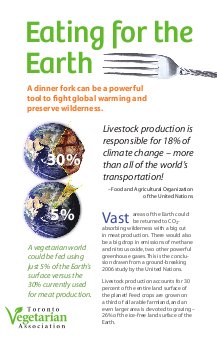
Eating for the Earth |
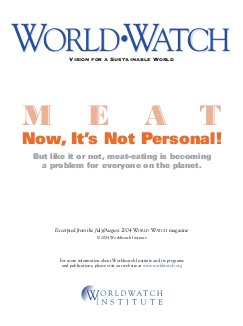 Meat, Now It's Not Personal |
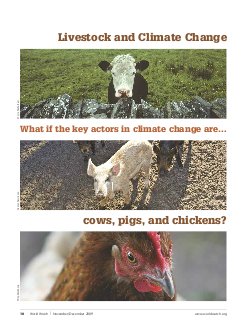 Livestock & Climate Change |
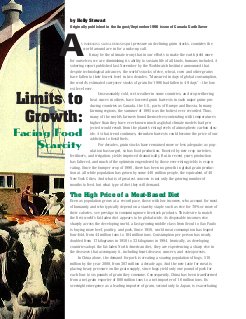
Limits to Growth: Facing Food Scarcity |
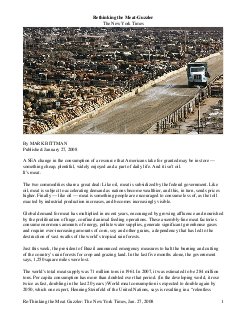
New York Times: Re-thinking the Meat Guzzler |
ENERGY INEFFICIENCY
On average, animal protein production in the U.S. requires 28 kilocalories (kcal) for every kcal of protein produced for human consumption. Beef and lamb are the most costly, in terms of fossil fuel energy input to protein output at 54:1 and 50:1, respectively. Turkey and chicken meat production are the most efficient (13:1 and 4:1, respectively). Grain production, on average, requires 3.3 kcal of fossil fuel for every kcal of protein produced. The U.S. now imports about 54 percent of its oil; by the year 2015, that import figure is expected to rise to 100 percent.
"Livestock Production: Energy Inputs and the Environment" by David Pimentel
In Canada, 3.5 acres (1.4 hectares) of land is used to feed each person. Most of this land is used for grazing or to grow feed crops. In contrast, only a half acre (0.2 hectares) is required to feed a vegetarian1 — seven times less land.
If the world were to move towards a vegetarian diet, large areas could be returned to wilderness. Unfortunately the opposite is still happening. Witness the ongoing destruction of rainforests to graze cattle and grow soy for animal feed. Considered to be the lungs of the Earth, tropical rainforests produce abundant oxygen, naturally store carbon, and sustain a rich biodiversity, providing a home to countless species of plants, animals and insects. In total, 785 species were driven to extinction in 2007 due to habitat destruction.
Grassland ecosystems are also threatened. About 70 percent of all grazing land in dry areas is considered degraded, mostly due to overgrazing, compaction and erosion attributable to livestock activity.
The vast majority of cereal crops grown in Canada — 77% to be exact — are directly fed to livestock, not people. And, on average, farm animals must be fed over 6 kilograms of crops to produce one kilogram of carcass meat for human consumption.4 Enough food is grown to easily feed everyone on the planet and alleviate high food prices. The problem is that most of it goes to fattening farm animals. Canadians and Americans consume almost 100 kilograms of meat, per person, per year. This involves the killing of 10 billion animals annually.
WATER
We're told to conserve water, we should take shorter showers and install low-flush toilets (all good ideas) but in fact agriculture accounts for 87 percent of all the fresh water consumed each year (US). The bulk of this goes toward water required for livestock forage and grain production. Every kilogram of beef produced takes 100,000 litres of water, and broiler chickens take 3,500 liters per kilogram produced. Vegetable crops directly require dramatically less: only 900 litres go into producing a kilogram of wheat, and 500 litres per kilogram of potatoes. Reducing meat in our diet goes a long way towards conserving our precious water supplies.
Animal agriculture is a leading consumer of water resources in the United States, Pimentel noted. Grain-fed beef production takes 100,000 liters of water for every kilogram of food. Raising broiler chickens takes 3,500 liters of water to make a kilogram of meat. In comparison, soybean production uses 2,000 liters for kilogram of food produced; rice, 1,912; wheat, 900; and potatoes, 500 liters. "Water shortages already are severe in the Western and Southern United States and the situation is quickly becoming worse because of a rapidly growing U.S. population that requires more water for all of its needs, especially agriculture," Pimentel observed.
 World's Waters Choking from Meat Consumption and Other Human Activities
World's Waters Choking from Meat Consumption and Other Human Activities
Greater meat consumption and demand for fossil fuels worldwide are expected to cause increasingly more harmful algal blooms and dead zones in coastal and freshwater areas. “Nutrient pollution in aquatic ecosystems, or eutrophication, is a rapidly growing environmental crisis,” said Mindy Selman, the lead author of a new report released today by the World Resources Institute (WRI). “Nearly 500 coastal areas already suffer from hypoxia. Our research indicates that number is expected to rise in the foreseeable future.”
WORLD HUNGER
“U.S. could feed 800 million people with grain that livestock eat, Cornell ecologist advises animal scientists,” read the headline for this August 1997 article:
“If all the grain currently fed to livestock in the United States were consumed directly by people, the number of people who could be fed would be nearly 800 million,” David Pimentel, professor of ecology in Cornell University's College of Agriculture and Life Sciences, reported at the July 24-26 meeting of the Canadian Society of Animal Science in Montreal. Or, if those grains were exported, it would boost the U.S. trade balance by $80 billion a year.
Currently some 800 million people on the planet now suffer from hunger or malnutrition, while the majority of corn and soya grown in the world — which could be feeding them, goes to feed cattle, pigs and chickens. By some estimates 20 vegetarians can be fed on the amount of land needed to feed one person consuming a meat-based diet.
Growing crops to feed animals means there is less land on which to grow crops for humans. The knock-on effect of any increase in meat production is likely to reduce the land and resources available for producing other foodstuffs and push future food prices further beyond the limits of affordability for the world's poorest people.
Sir Paul McCartney sums it all up: "If anyone wants to save the planet, all they have to do is just stop eating meat. That's the single most important thing you could do. It's staggering when you think about it. Vegetarianism takes care of so many things in one shot: ecology, famine, cruelty."
LINKS:
- Earthsave
"A reduction in meat consumption is probably the most potent single act individuals can take in the effort to halt the destruction of the environment and preserve our precious resources. Reducing meat consumption conserves water, saves energy, preserves top soil, reduces our dependence on chemical pesticides and fertilizers, and protects forests. All this while improving our health."
— John Robbins, Founder of Earthsave International - GoVeg.com
- Veg TV
- Vegetarian Society UK - www.vegsoc.org
- Vegetarian Society UK - Environmental Resources
- Young Veggie.org - www.youngveggie.org
- Vegetarian Diet Info - www.vegetarian-diet.info/

Back to TOP OF PAGE
“The single action that a person can take, an individual can take, to reduce carbon emissions is vegetarianism...There are many things that people can do to reduce their carbon emissions, but changing your light bulb and many of the things are much less effective than changing your diet, because if you eat further down on the food chain rather than animals, which have produced many greenhouse gases, and used much energy in the process of growing that meat, you can actually make a bigger contribution in that way than just about anything. So, that, in terms of individual action, is perhaps the best thing you can do.”
Dr. James Hansen, NASA Climatologist